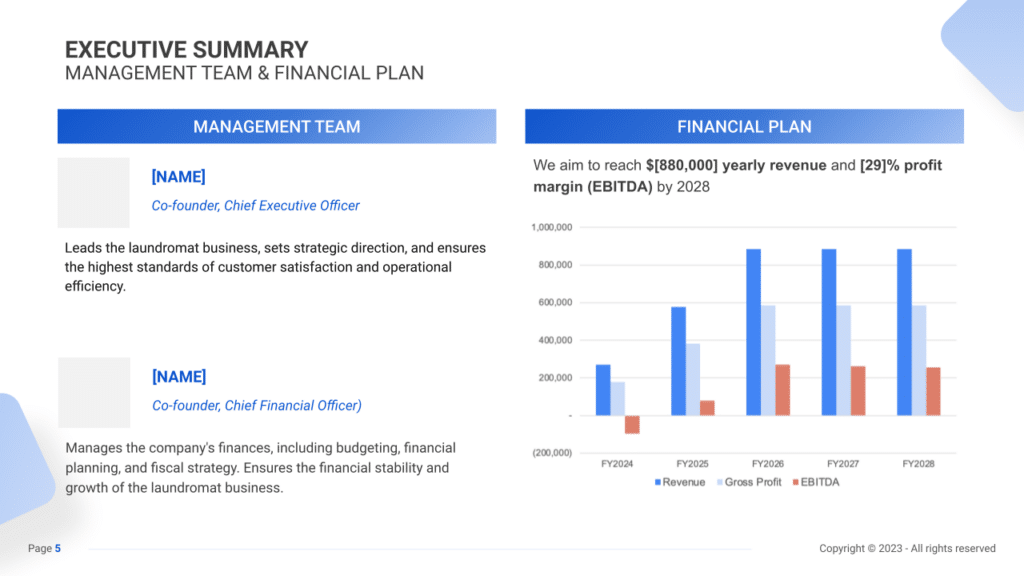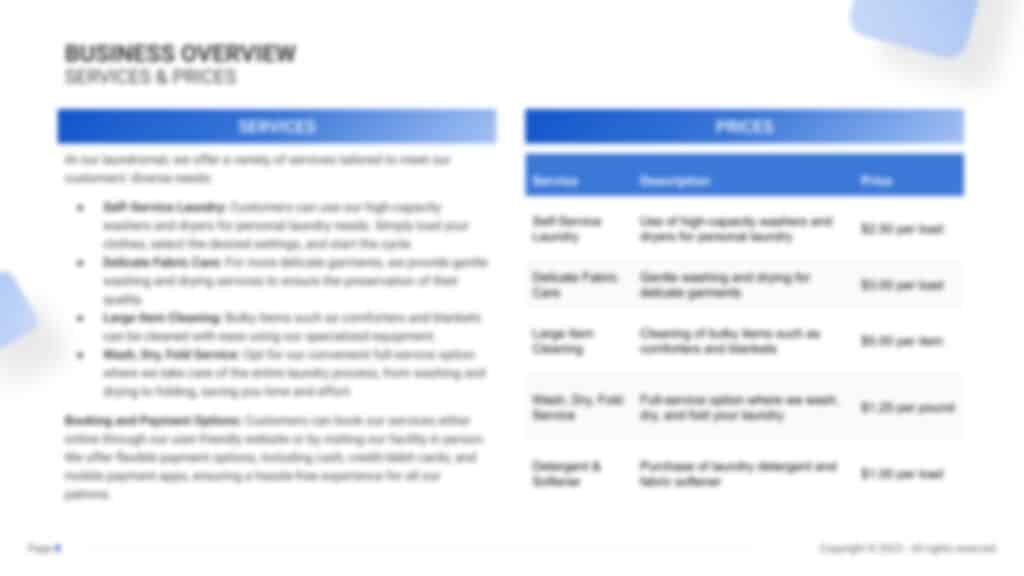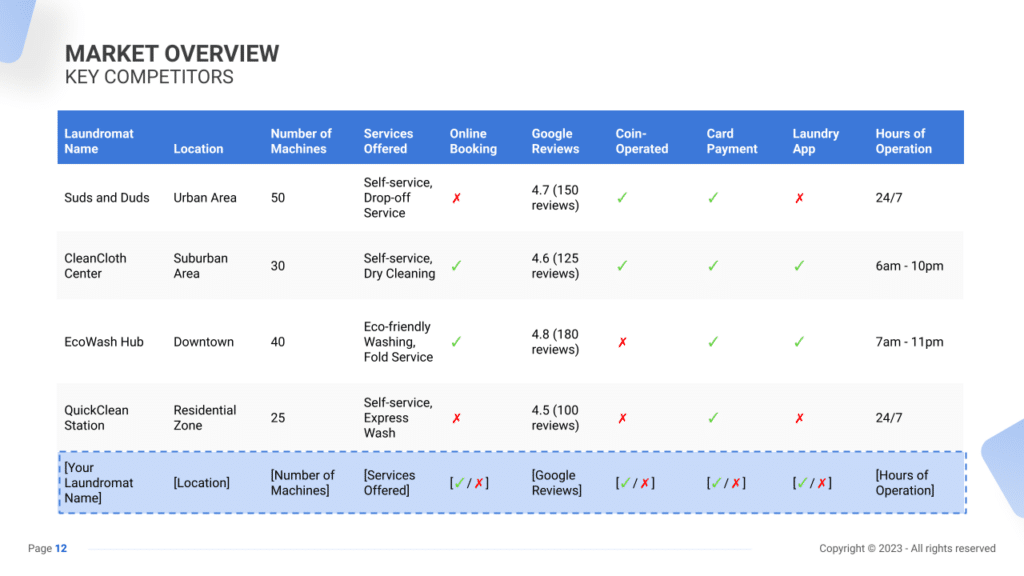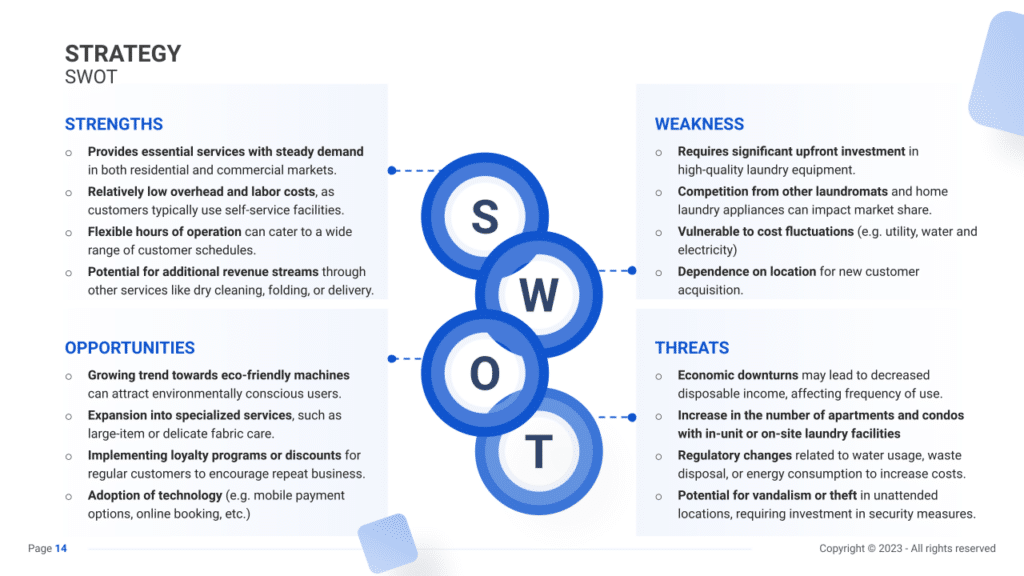Laundromat Business Plan PDF Example

Creating a comprehensive business plan is crucial for launching and running a successful laundromat business. This plan serves as your roadmap, detailing your vision, operational strategies, and financial plan. It helps establish your laundromat business’s identity, navigate the competitive market, and secure funding for growth.
This article not only breaks down the critical components of a laundromat business plan but also provides an example of a business plan to help you craft your own.
Whether you’re an experienced entrepreneur or new to the service industry, this guide, complete with a business plan example, lays the groundwork for turning your laundromat business concept into reality. Let’s dive in!
The Plan
Our laundromat business plan is meticulously crafted to encompass all vital elements essential for a holistic and strategic framework. It delineates the laundromat’s operational processes, marketing approaches, market dynamics, competitive landscape, management structure, and financial outlook.
- Executive Summary: Offers a concise overview of the laundromat business concept, including the market analysis, the expertise of the management team, and strategic financial planning.
- Business Overview: Delves into the specifics of the laundromat’s operational model and offerings:
- Facility & Location: Describes the laundromat’s infrastructure, including size, layout, and the strategic advantages of its location for customer accessibility and business visibility.
- Services & Pricing: Lists the laundromat services, such as self-service laundry, wash and fold services, and specialized care for delicate items, along with a transparent pricing model.
- Market Overview: Provides an in-depth analysis of the laundry service market, positioning the laundromat within the competitive landscape:
- Key Stats: Shares insights on the size of the laundry service market, growth trends, and industry-specific statistics.
- Key Trends: Highlights recent trends impacting the laundromat and laundry service industry, such as technological advancements and consumer preferences.
- Key Competitors: Evaluates the main competitors in the vicinity, outlining how the laundromat differentiates itself in terms of services, technology, and customer experience.
- Strategy: Outlines the strategic approach to achieving business growth and attracting a loyal customer base:
- SWOT Analysis: A comprehensive analysis of strengths, weaknesses, opportunities, and threats to navigate the market effectively.
- Marketing Plan: Details the marketing strategies and channels to promote the laundromat services, enhance brand visibility, and engage with the target audience.
- Timeline: Establishes key milestones, from the initial setup phase to operational benchmarks within the first year and beyond.
- Management: Provides information on the laundromat’s management team, highlighting their backgrounds, roles, and contributions to the business’s success.
- Financial Plan: Projects the laundromat’s financial trajectory over the next five years, including revenue streams, profit margins, and key financial metrics to ensure sustainability and growth.
Executive Summary
The Executive Summary introduces your laundromat’s business plan, offering a concise overview of your laundromat and its services. It should detail your market positioning, the range of laundry services you provide, its location, size, and an outline of day-to-day operations.
This section should also explore how your laundromat will integrate into the local market, including the number of direct competitors within the area, identifying who they are, along with your laundromat’s unique selling points that differentiate it from these competitors.
Furthermore, you should include information about the management and co-founding team, detailing their roles and contributions to the laundromat’s success.
Additionally, a summary of your financial projections, including revenue and profits over the next five years, should be presented here to provide a clear picture of your laundromat’s financial plan.
Make sure to cover here
_ Business Overview
_ Market Overview
_ Management Team
_ Financial Plan


Dive deeper into Executive Summary
Business Overview
For a Laundromat, the Business Overview section can be effectively divided into 2 main slides:
Facility & Location
Briefly describe the laundromat’s physical setup, focusing on its functionality, equipment quality, and the comfortable environment it provides for customers.
Mention the laundromat’s location, emphasizing its accessibility and the convenience it offers to clients, such as proximity to residential areas or ease of parking. Highlight why this location is beneficial in attracting your target clientele, considering factors like high-density living areas without in-unit laundry facilities.
Services & Pricing
Detail the range of laundry services offered, from self-service washing and drying to additional services such as dry cleaning, ironing, folding, and possibly pickup and delivery options.
Outline your pricing strategy, ensuring it is competitive yet reflective of the service quality and convenience you provide. Highlight any special offerings, such as discounted rates during off-peak hours, loyalty programs, or monthly memberships that offer unlimited usage or discounts, encouraging repeat business and customer loyalty.
Make sure to cover here
_ Facility & Location
_Services & Pricing


Market Overview
Industry size & growth
In the Market Overview of your laundromat business plan, begin by assessing the size of the laundry services industry and its growth potential. This analysis is fundamental for grasping the market’s breadth and identifying opportunities for expansion.
Consider factors such as the number of households without access to in-home laundry facilities and the growing trend of urban living, which could influence demand for laundromat services.
Key market trends
Move on to discuss recent market trends, such as the increasing customer preference for convenience in laundry services, including the adoption of app-based services for scheduling and payment, eco-friendly washing technologies, and the addition of value-added services like dry cleaning, ironing, and folding.
Highlight the shift towards more hygienic and sanitized laundry practices, especially in the context of health and safety concerns. These trends indicate a shift in consumer expectations and the evolving dynamics of the laundry service market.
Key competitors
Next, analyze the competitive landscape, which may range from traditional coin-operated laundromats to full-service laundry businesses offering a variety of ancillary services. Consider how at-home laundry appliances and subscription-based laundry services impact the market.
Highlight what sets your laundromat apart, be it through superior technology, exceptional customer service, or unique offerings like lounge areas, Wi-Fi, and coffee services.
Make sure to cover here
_ Industry size & growth
_ Key competitors
_ Key market trends




Dive deeper into Key competitors
Strategy
SWOT
First, conduct a SWOT analysis for the laundromat, identifying Strengths (such as modern and efficient machines, convenient location, and additional services like folding or dry cleaning), Weaknesses (including potential downtimes due to machine maintenance or strong competition in the area), Opportunities (for instance, a growing demand for laundry services among urban dwellers without home laundry facilities), and Threats (such as economic downturns that might reduce the frequency of laundry service usage).
Marketing Plan
Next, formulate a marketing strategy that details the methods to attract and retain customers through targeted advertising, promotional offers (like ‘first wash free’ for new customers or discounted rates during off-peak hours), an engaging online presence with useful laundry tips and community involvement (perhaps by sponsoring local sports teams or participating in community events).
Timeline
Finally, establish a comprehensive timeline that outlines key milestones for the laundromat’s launch, marketing initiatives, customer base development, and potential expansion goals, ensuring the business progresses with clear direction and intent. This might include dates for the initial opening, the rollout of new services, community event participation, and periodic evaluations of customer feedback and service offerings.
Make sure to cover here
_ SWOT
_ Marketing Plan
_ Timeline




Dive deeper into SWOT
Dive deeper into Marketing Plan
Management
The Management section focuses on the laundromat business’s management and their direct roles in daily operations and strategic direction. This part is crucial for understanding who is responsible for making key decisions and driving the laundromat business toward its financial and operational goals.
For your laundromat business plan, list the core team members, their specific responsibilities, and how their expertise supports the business.


Financial Plan
The Financial Plan section is a comprehensive analysis of your financial projections for revenue, expenses, and profitability. It lays out your laundromat business’s approach to securing funding, managing cash flow, and achieving breakeven.
This section typically includes detailed forecasts for the first 5 years of operation, highlighting expected revenue, operating costs and capital expenditures.
For your laundromat business plan, provide a snapshot of your financial statement (profit and loss, balance sheet, cash flow statement), as well as your key assumptions (e.g. number of customers and prices, expenses, etc.).
Make sure to cover here
_ Profit and Loss
_ Cash Flow Statement
_ Balance Sheet
_ Use of Funds









